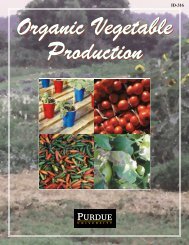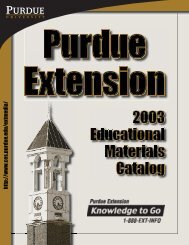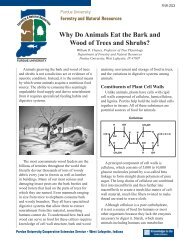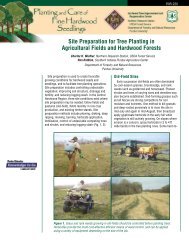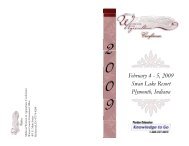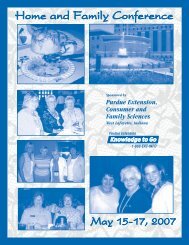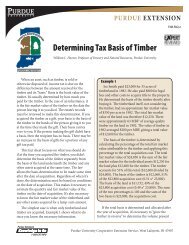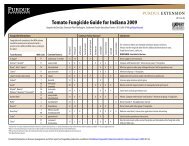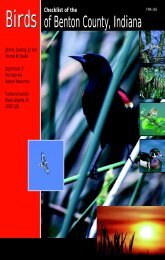Diseases of Soybean: Frogeye Leaf Spot, BP-131-W - Purdue ...
Diseases of Soybean: Frogeye Leaf Spot, BP-131-W - Purdue ...
Diseases of Soybean: Frogeye Leaf Spot, BP-131-W - Purdue ...
You also want an ePaper? Increase the reach of your titles
YUMPU automatically turns print PDFs into web optimized ePapers that Google loves.
www.btny.purdue.edu<br />
diseases <strong>of</strong> soybean<br />
<strong>Purdue</strong> extension<br />
<strong>Frogeye</strong> <strong>Leaf</strong> spot<br />
Andreas Westphal, T. Scott Abney, and Gregory Shaner<br />
<strong>BP</strong>-<strong>131</strong>-W<br />
<strong>Purdue</strong> University Department <strong>of</strong> Botany and Plant Pathology and USDA-ARS<br />
<strong>Frogeye</strong> leaf spot is an important foliar disease in hot, humid regions <strong>of</strong> the United<br />
States. It has been a problem in southern states for several years. Typically, the<br />
disease occurs sporadically in Indiana and other central states, but its prevalence<br />
and severity have increased markedly in these areas in the last five years. In<br />
Indiana, frogeye leaf spot is encountered more <strong>of</strong>ten in the south, but can occur<br />
farther north when weather is favorable for disease development.<br />
symptoms<br />
Infection can occur at<br />
any stage <strong>of</strong> soybean<br />
development, but most<br />
<strong>of</strong>ten occurs after flowering.<br />
The most common initial<br />
symptoms are small, yellow<br />
spots on the leaves. These<br />
spots eventually enlarge<br />
to a diameter <strong>of</strong> about ¼<br />
inch. The centers <strong>of</strong> these<br />
lesions become gray to<br />
brown and have reddish<br />
purple margins (Figure 1).<br />
These leaf spots are diagnostic<br />
symptoms but are<br />
<strong>of</strong>ten mistaken for herbicide<br />
drift or other leaf diseases.<br />
When infections are numerous,<br />
spots coalesce to create<br />
irregular patterns.<br />
Although less frequent,<br />
lesions also develop on<br />
stems and pods. These<br />
lesions are less diagnostic<br />
than leaf lesions. Stem<br />
lesions are somewhat red<br />
when young, and darken<br />
with age (Figure 2). They<br />
lack the characteristic tan<br />
center and reddish purple<br />
border <strong>of</strong> leaf lesions.<br />
Pod lesions are circular<br />
or oblong, reddish-brown,<br />
Figure 1. <strong>Leaf</strong> symptoms <strong>of</strong> frogeye leaf spot.<br />
Figure 2. <strong>Soybean</strong> stem lesions caused by the frogeye leaf<br />
spot pathogen.<br />
Figure 3. <strong>Soybean</strong> pod lesions caused by the frogeye leaf<br />
spot pathogen.<br />
and slightly sunken (Figure 3). Under humid conditions, lesions on any part <strong>of</strong> the<br />
plant may develop dark centers when the fungus is producing spores. The fungus<br />
that causes the disease may grow through the pod walls and invade seed. Infected
Gail Ruhl, <strong>Purdue</strong> Plant and Pest Diagnostic Laboratory<br />
<strong>Diseases</strong> <strong>of</strong> <strong>Soybean</strong> <strong>Frogeye</strong> <strong>Leaf</strong> <strong>Spot</strong> <strong>BP</strong>-<strong>131</strong>-W <strong>Purdue</strong> extension<br />
Figure 4. Seed damaged by frogeye leaf spot and other pathogens.<br />
seeds may show a range <strong>of</strong> symptoms (Figure 4). They<br />
may have no symptoms, or they may appear dark, shriveled,<br />
and may have a cracked seed coat.<br />
Causal Agent<br />
Cercospora sojina causes frogeye leaf spot. This fungus<br />
produces long, narrow spores that arise in clusters from<br />
dark cushions at the centers <strong>of</strong> lesions during warm,<br />
humid weather. When inspecting lesions with a good<br />
hand lens, it is possible to see black dots with masses <strong>of</strong><br />
long, silvery spores in a lesion’s center. A related fungus,<br />
Cercospora kikuchii, causes Cercospora leaf spot and<br />
purple seed stain, but its spores are much longer than<br />
those <strong>of</strong> Cercospora sojina.<br />
disease Cycle<br />
Cercospora sojina survives in infected seed and plant<br />
debris from an infected crop. Infected seed may germinate<br />
poorly, and plants that do emerge from infected seed are<br />
<strong>of</strong>ten stunted and may have lesions on the cotyledons.<br />
These lesions produce spores that can be inoculum for<br />
leaf infections.<br />
The fungus can also produce spores on the residue<br />
<strong>of</strong> a previous soybean crop. Although most soybean is<br />
grown in rotation with corn (meaning there is little soybean<br />
residue in newly planted soybean fields), enough soybean<br />
residue can remain to supply spores to begin an epidemic.<br />
Wind readily transports the spores <strong>of</strong> Cercospora sojina<br />
(whether these have been produced on residue or new<br />
lesions) from one field to another.<br />
Spore production and infection requires warm, humid<br />
weather. Leaves are most susceptible to infection when<br />
they are just emerging and become less susceptible<br />
as they mature. This range <strong>of</strong> susceptibility can lead to<br />
a layered occurrence <strong>of</strong> disease in the plant canopy,<br />
depending on how conducive conditions were as each leaf<br />
layer emerged.<br />
<strong>Frogeye</strong> leaf spot is a polycyclic disease, meaning<br />
that the number <strong>of</strong> lesions on the plant will continue to<br />
increase as long as the weather is favorable for infection.<br />
The greater the number <strong>of</strong> lesions, the greater the reduction<br />
<strong>of</strong> green leaf area, and the greater the reduction in<br />
yield. If favorable conditions for infection persist until late<br />
in the season, the fungus will infect pods and seeds.<br />
Management<br />
<strong>Frogeye</strong> leaf spot can cause significant yield losses.<br />
Management practices are aimed at reducing the<br />
amount <strong>of</strong> inoculum available for infection in the field and<br />
protecting plants from infection.<br />
Planting<br />
Plant clean, pathogen-free seed. The relative<br />
contribution <strong>of</strong> primary inoculum (the spores that initiate<br />
disease in the crop) in infected seed versus crop residue<br />
is not known. It is believed that residue may be a more<br />
significant source <strong>of</strong> inoculum than infected seed, but<br />
infected seed may establish the fungus in new areas.<br />
Tillage<br />
Burying infected soybean residue will help reduce the<br />
inoculum in a field. Many growers use fairly clean tillage<br />
prior to planting corn, which destroys and buries soybean<br />
residue in the soybean-corn rotation, which may explain<br />
why frogeye leaf spot has not been a serious problem in<br />
Indiana for many years. However, severe frogeye leaf spot<br />
outbreaks in several Indiana areas in 2005 indicate that<br />
the disease is capable <strong>of</strong> establishing itself here under<br />
current tillage practices.<br />
Rotation<br />
Rotating out <strong>of</strong> infected soybean for at least two years<br />
will help reduce the frogeye leaf spot risk.<br />
Resistant Varieties<br />
Several different genes for frogeye leaf spot resistance<br />
have been discovered and described in soybean. Because<br />
the disease is a more chronic problem in the southern<br />
United States, resistance is more commonly available<br />
in varieties <strong>of</strong> maturity group V and higher. Resistance<br />
is available in some, perhaps many, varieties adapted<br />
to Indiana. However, some varieties were clearly very<br />
susceptible to frogeye leaf spot during 2005.<br />
Rcs1, Rcs2, and Rcs3 are three named genes for<br />
frogeye leaf spot resistance, and additional sources<br />
<strong>of</strong> resistance have been reported. There are several<br />
races <strong>of</strong> the pathogen, which are distinguished by their
<strong>Diseases</strong> <strong>of</strong> <strong>Soybean</strong> <strong>Frogeye</strong> <strong>Leaf</strong> <strong>Spot</strong> <strong>BP</strong>-<strong>131</strong>-W <strong>Purdue</strong> extension<br />
ability to infect soybean varieties with different genes<br />
for resistance. A soybean variety with one particular<br />
gene for resistance will be resistant to some races <strong>of</strong><br />
the pathogen, but not others. Apparently, the Rcs3 gene<br />
confers resistance to all races that occur in Indiana, but<br />
the information about the races here is very limited.<br />
Chemical Control<br />
Fungicide seed treatments can reduce the risk <strong>of</strong><br />
infection. Spray applications <strong>of</strong> fungicides after growth<br />
stage R1 can reduce disease severity. But applications<br />
made at stage R3 are considered most effective in<br />
southern states.<br />
<strong>Frogeye</strong> leaf spot has caused only limited problems<br />
in Indiana in recent years. But with the arrival <strong>of</strong> Asian<br />
soybean rust and the increased awareness <strong>of</strong> leaf<br />
diseases in soybean, frogeye leaf spot will probably be<br />
given more attention than in the past.<br />
Acknowledgements<br />
Part <strong>of</strong> the information included in this publication is<br />
derived from research supported by the Indiana <strong>Soybean</strong><br />
Board and North Central <strong>Soybean</strong> Research Program.<br />
Figure 4 courtesy <strong>of</strong> Gail Ruhl. All other photos by the authors.<br />
<strong>Purdue</strong> AgriCuLture<br />
It is the policy <strong>of</strong> the <strong>Purdue</strong> University Cooperative Extension Service, David C. Petritz, Director, that all persons shall have equal opportunity and access to the programs and<br />
facilities without regard to race, color, sex, religion, national origin, age, marital status, parental status, sexual orientation, or disability. <strong>Purdue</strong> University is an Affirmative<br />
Action employer. This material may be available in alternative formats.<br />
1-888-EXT-INFO<br />
http://www.ces.purdue.edu/new<br />
8/06



